CCAT2, a novel noncoding RNA mapping to 8q24, underlies metastatic progression and chromosomal instability in colon cancer
- PMID: 23796952
- PMCID: PMC3759721
- DOI: 10.1101/gr.152942.112
CCAT2, a novel noncoding RNA mapping to 8q24, underlies metastatic progression and chromosomal instability in colon cancer
Abstract
The functional roles of SNPs within the 8q24 gene desert in the cancer phenotype are not yet well understood. Here, we report that CCAT2, a novel long noncoding RNA transcript (lncRNA) encompassing the rs6983267 SNP, is highly overexpressed in microsatellite-stable colorectal cancer and promotes tumor growth, metastasis, and chromosomal instability. We demonstrate that MYC, miR-17-5p, and miR-20a are up-regulated by CCAT2 through TCF7L2-mediated transcriptional regulation. We further identify the physical interaction between CCAT2 and TCF7L2 resulting in an enhancement of WNT signaling activity. We show that CCAT2 is itself a WNT downstream target, which suggests the existence of a feedback loop. Finally, we demonstrate that the SNP status affects CCAT2 expression and the risk allele G produces more CCAT2 transcript. Our results support a new mechanism of MYC and WNT regulation by the novel lncRNA CCAT2 in colorectal cancer pathogenesis, and provide an alternative explanation of the SNP-conferred cancer risk.
Figures
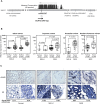
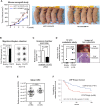
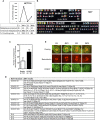
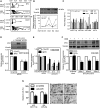
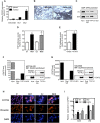
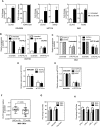
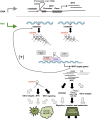
Similar articles
-
The Long Noncoding RNA CCAT2 Induces Chromosomal Instability Through BOP1-AURKB Signaling.Gastroenterology. 2020 Dec;159(6):2146-2162.e33. doi: 10.1053/j.gastro.2020.08.018. Epub 2020 Aug 15. Gastroenterology. 2020. PMID: 32805281 Free PMC article.
-
The Expression of CCAT2, a Novel Long Noncoding RNA Transcript, and rs6983267 Single-Nucleotide Polymorphism Genotypes in Colorectal Cancers.Oncology. 2017;92(1):48-54. doi: 10.1159/000452143. Epub 2016 Nov 23. Oncology. 2017. PMID: 27875818
-
A novel mechanism of lncRNA and miRNA interaction: CCAT2 regulates miR-145 expression by suppressing its maturation process in colon cancer cells.Mol Cancer. 2017 Sep 30;16(1):155. doi: 10.1186/s12943-017-0725-5. Mol Cancer. 2017. PMID: 28964256 Free PMC article.
-
The Roles of the Colon Cancer Associated Transcript 2 (CCAT2) Long Non-Coding RNA in Cancer: A Comprehensive Characterization of the Tumorigenic and Molecular Functions.Int J Mol Sci. 2021 Nov 19;22(22):12491. doi: 10.3390/ijms222212491. Int J Mol Sci. 2021. PMID: 34830370 Free PMC article. Review.
-
8q24.21 Locus: A Paradigm to Link Non-Coding RNAs, Genome Polymorphisms and Cancer.Int J Mol Sci. 2021 Jan 22;22(3):1094. doi: 10.3390/ijms22031094. Int J Mol Sci. 2021. PMID: 33499210 Free PMC article. Review.
Cited by
-
Discovery of prognostic lncRNAs in colorectal cancer using spatial transcriptomics.NPJ Precis Oncol. 2024 Oct 10;8(1):230. doi: 10.1038/s41698-024-00728-1. NPJ Precis Oncol. 2024. PMID: 39390212 Free PMC article.
-
Comparative transcriptome of normal and cancer-associated fibroblasts.BMC Cancer. 2024 Oct 5;24(1):1231. doi: 10.1186/s12885-024-13006-x. BMC Cancer. 2024. PMID: 39369238 Free PMC article.
-
Unraveling the Regulatory Role of HuR/microRNA Axis in Colorectal Cancer Tumorigenesis.Cancers (Basel). 2024 Sep 18;16(18):3183. doi: 10.3390/cancers16183183. Cancers (Basel). 2024. PMID: 39335155 Free PMC article. Review.
-
The Association between the NLRP3 Inflammasome and Specific Long-Non Coding RNAs (lncRNAs) in Cancer; New Perspective and Summary of Recent Studies.Cell Biochem Biophys. 2024 Sep 16. doi: 10.1007/s12013-024-01494-4. Online ahead of print. Cell Biochem Biophys. 2024. PMID: 39285156 Review.
-
Expression and significant roles of the long non-coding RNA CASC19/miR-491-5p/HMGA2 axis in the development of gastric cancer.World J Gastrointest Oncol. 2024 Aug 15;16(8):3559-3584. doi: 10.4251/wjgo.v16.i8.3559. World J Gastrointest Oncol. 2024. PMID: 39171190 Free PMC article.
References
-
- Ambros V 2001. microRNAs: Tiny regulators with great potential. Cell 107: 823–826 - PubMed
-
- Aoki K, Aoki M, Sugai M, Harada N, Miyoshi H, Tsukamoto T, Mizoshita T, Tatematsu M, Seno H, Chiba T, et al. 2007. Chromosomal instability by β-catenin/TCF transcription in APC or β-catenin mutant cells. Oncogene 26: 3511–3520 - PubMed
-
- Bejerano G, Pheasant M, Makunin I, Stephen S, Kent WJ, Mattick JS, Haussler D 2004. Ultraconserved elements in the human genome. Science 304: 1321–1325 - PubMed
Publication types
MeSH terms
Substances
Grants and funding
- P30 CA016672/CA/NCI NIH HHS/United States
- P01 CA130821/CA/NCI NIH HHS/United States
- U01 CA074799/CA/NCI NIH HHS/United States
- 5U24 CA074806/CA/NCI NIH HHS/United States
- CA135444/CA/NCI NIH HHS/United States
- CA016672/CA/NCI NIH HHS/United States
- U24 CA074806/CA/NCI NIH HHS/United States
- R01 CA135444/CA/NCI NIH HHS/United States
- P30 CA060553/CA/NCI NIH HHS/United States
- 090532/WT_/Wellcome Trust/United Kingdom
- UM1 CA167551/CA/NCI NIH HHS/United States
- CA-95-011/CA/NCI NIH HHS/United States
- U01 CA074783/CA/NCI NIH HHS/United States
- U24 CA074783/CA/NCI NIH HHS/United States
- CA16672/CA/NCI NIH HHS/United States
- 16459/CRUK_/Cancer Research UK/United Kingdom
- U24 CA074799/CA/NCI NIH HHS/United States
- U01 CA074806/CA/NCI NIH HHS/United States
- U24 CA074800/CA/NCI NIH HHS/United States
- P30 CA071789/CA/NCI NIH HHS/United States
- U01 CA074800/CA/NCI NIH HHS/United States
LinkOut - more resources
Full Text Sources
Other Literature Sources

